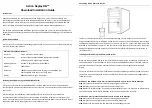
Company
Confidential
Reso
Ltd
T/A
QDOS
Issue
N°
1
4
th
July
2014
1.
The
use
of
the
WEEE
symbol
indicates
that
this
product
may
not
be
treated
as
household
waste.
By
ensuring
this
product
is
disposed
of
correctly,
you
will
help
protect
the
environment.
For
more
detailed
information
about
the
recycling
of
this
product,
please
contact
your
local
authority,
your
household
waste
disposal
service
provider
or
the
shop
where
you
purchased
the
product.
2.
Do
not
incinerate
or
dispose
of
your
product
in
a
fire
or
microwave
For Your Safety
Failure
to
read
and
follow
these
safety
warnings
could
result
in
fire,
explosion,
electrical
shock
or
other
hazard,
causing
serious
and/or
fatal
injury
and/or
property
damage
Follow
all
operating
and
usage
instructions
Before
use
always
check
for
damage
and
use
only
the
battery
supplied
or
recommended
Do
not
attempt
to
open
or
dismantle
the
unit
and
never
disassemble
or
modify
the
components
of
the
QDOS
Q
‐
PIC
selfie
shooter
KEEP
AWAY
FROM
FIRE.
Avoid
throwing
the
device
into
fire
or
storing
near
to
any
heating
source
Keep
away
from
corrosive
materials
To
prevent
short
circuit
or
other
potential
hazards,
keep
small
electrically
conductive
parts
away
from
the
QDOS
Q
‐
PIC
and
its
connecting
sockets
Do
not
allow
small
children
to
play
with
the
QDOS
Q
‐
PIC
selfie
shooter
unsupervised
In
the
unlikely
event
of
over
‐
heating
or
if
you
notice
any
unusual
smells,
distortions,
discoloring
or
other
abnormal
phenomena,
please
stop
using
the
QDOS
Q
‐
PIC
selfie
shooter
immediately
and
seek
the
advice
of
a
qualified
electronic
technician
This
equipment
has
been
tested
and
found
to
comply
with
the
limits
for
a
Class
B
digi
-
tal
device,
pursuant
to
Part
15
of
the
FCC
Rules.
These
limits
are
designed
to
provide
reasonable
protection
against
harmful
interference
in
a
residential
installation.
This
e
-
quipment
generates
uses
and
can
radiate
radio
frequency
energy
and,
if
not
installed
and
used
in
accordance
with
the
instructions,
may
cause
harmful
interference
to
rad
-
io
communications.
However,
there
is
no
guarantee
that
interference
will
not
occur
i
-
n
a
particular
installation.
If
this
equipment
does
cause
harmful
interference
to
radio
or
television
reception,
which
can
be
determined
by
turning
the
equipment
off
and
o
-
n,
the
user
is
encouraged
to
try
to
correct
the
interference
by
one
or
more
of
the
foll
-
owing
measures:
‐‐
Reorient
or
relocate
the
receiving
antenna.
‐‐
Increase
the
separation
between
the
equipment
and
receiver.
‐‐
Connect
the
equipment
into
an
outlet
on
a
circuit
different
from
that
to
which
the
re
-
ceiver
is
connected.
‐‐
Consult
the
dealer
or
an
experienced
radio/TV
technician
for
help.
Changes
or
modifications
not
expressly
approved
by
the
party
responsible
for
compli
-
ance
could
void
the
user's
authority
to
operate
the
equipment.


























